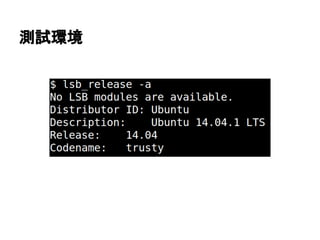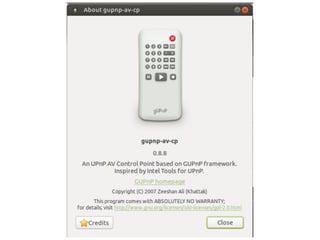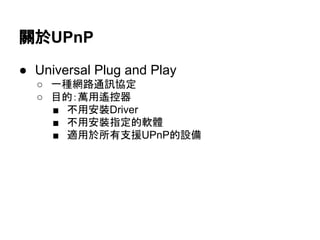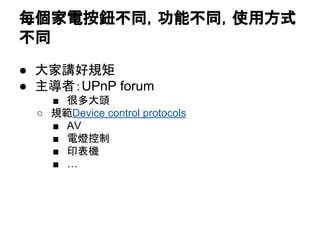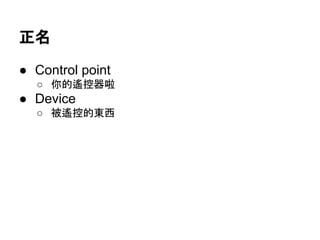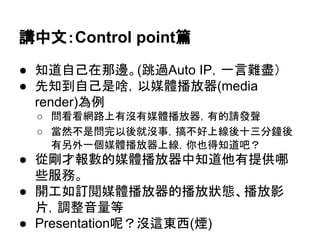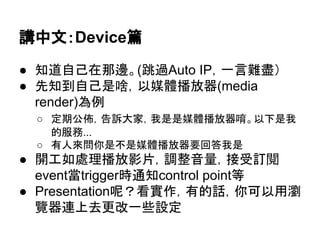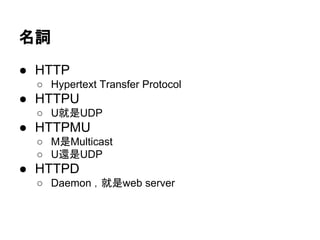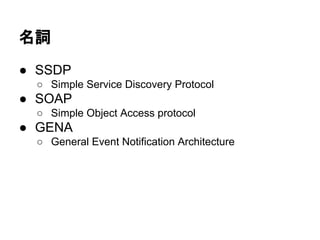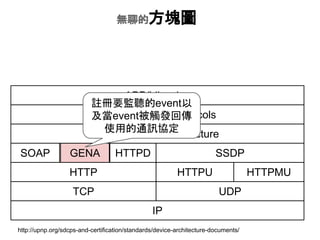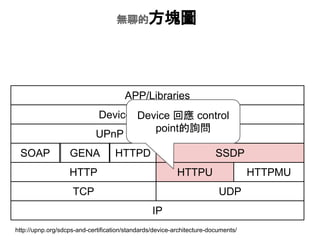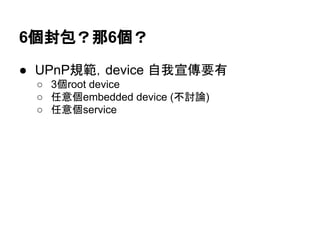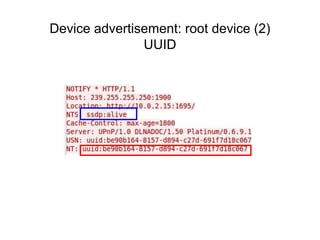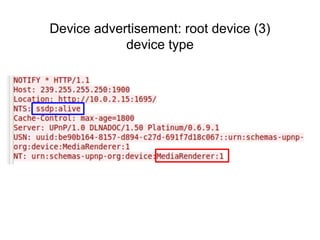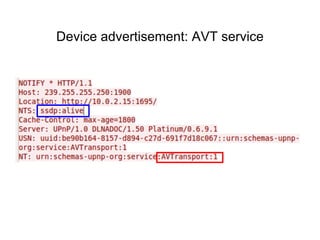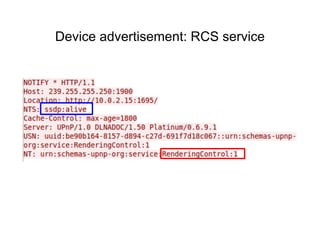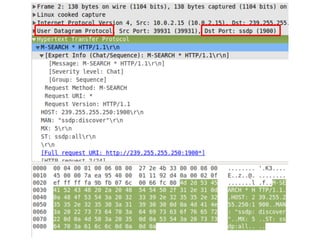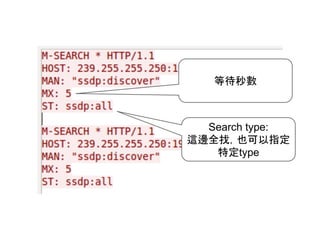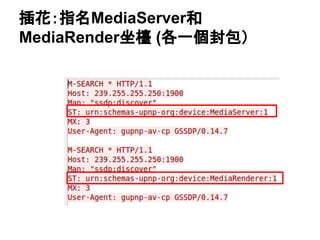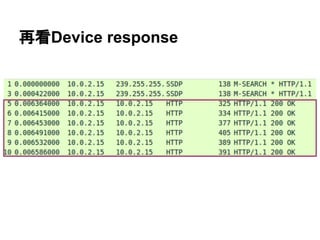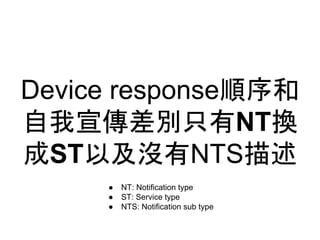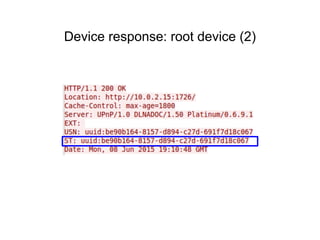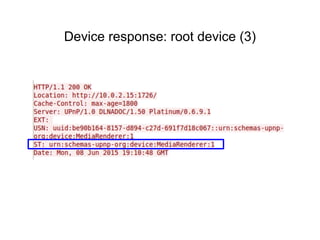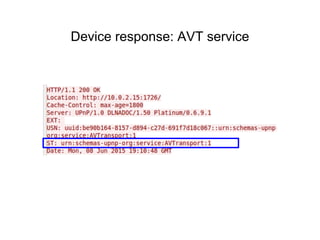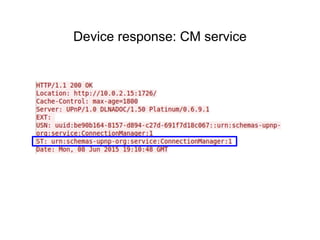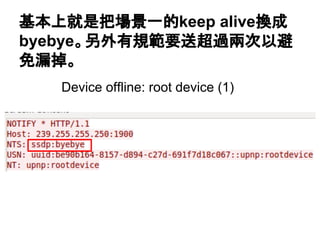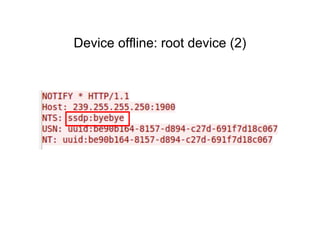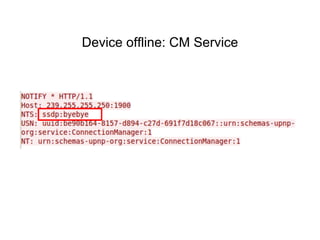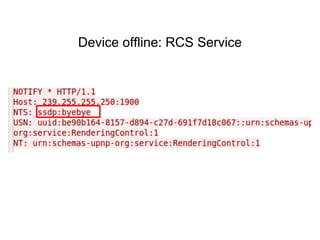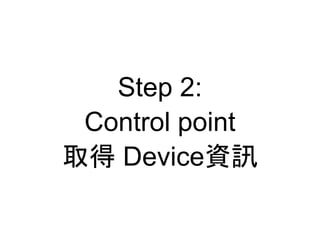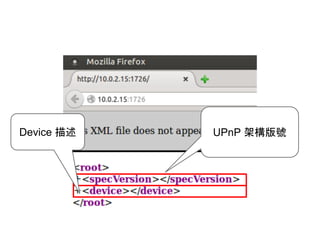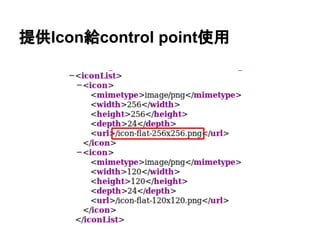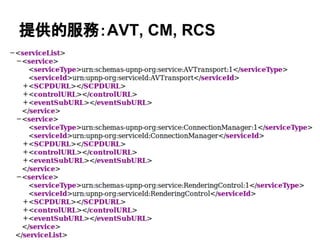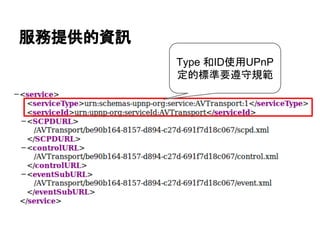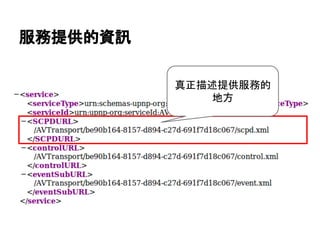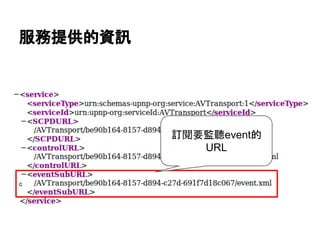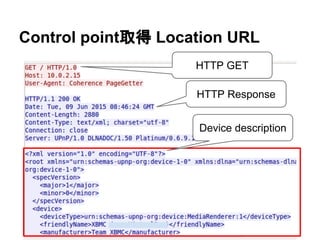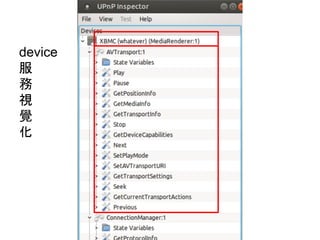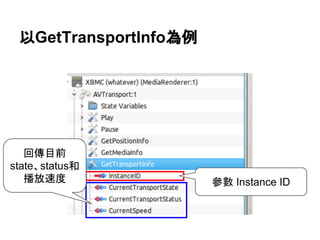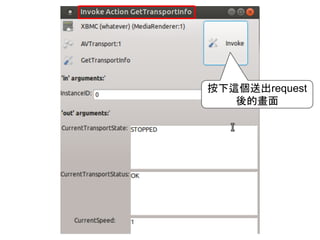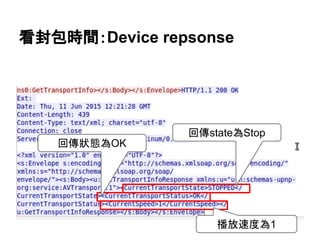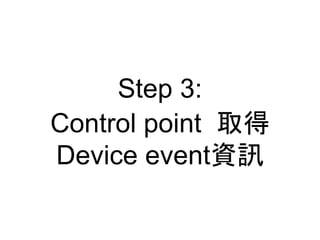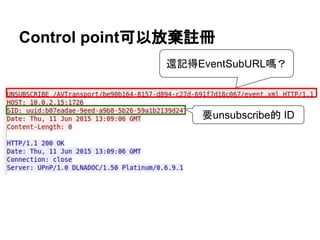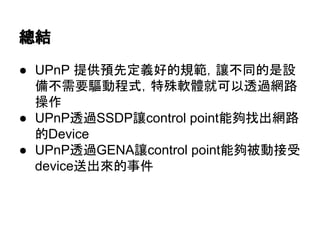UPnP 1.0 簡介
- 1. Wen Liao UPnP 1.0 簡介 台北市
- 3. 测试环境
- 4. 测试环境
- 5. 测试环境
- 7. 测试环境
- 8. 關於UPnP ● Universal Plug and Play ○ 一種網路通訊協定 ○ 目的:萬用遙控器 ■ 不用安裝Driver ■ 不用安裝指定的軟體 ■ 適用於所有支援UPnP的設備
- 10. 萬用遙控器要處理的問題 ● 以家電的遙控器比喻 ○ 每個家電按鈕不同,功能不同,使用方式不同 ■ 就算同一種家電,不同廠牌,甚至同廠牌不同型號 一樣有相同的問題 ○ 要怎麼知道現在有那幾台設備可以用? ■ A牌電風扇 ■ B牌播放器 ■ C牌電燈 ○ 要怎麼知道設備狀態?
- 11. 每個家電按鈕不同,功能不同,使用方式 不同 ● 大家講好規矩 ● 主導者:UPnP forum ■ 很多大頭 ○ 規範Device control protocols ■ AV ■ 電燈控制 ■ 印表機 ■ …
- 13. 要怎麼知道設備狀態? ● 遙控器直接問 ● 遙控器告訴設備說哪些狀態更動的時候要跟 我說,如 ○ 播放器更動播放內容 ○ ...
- 14. 觀念 ● 整個控制可以分成兩個角色 ○ 遙控器 ○ 設備 ● 遙控器的按鈕,可以看成呼叫服務 ○ 將溫度設定成25度 ○ 切到下一個頻道 ● 接樓上,所以這是一個遠端呼叫的概念。洋人 的話就是remote procedure call,簡稱RPC
- 15. 进入正题
- 16. 正名 ● Control point ○ 你的遙控器啦 ● Device ○ 被遙控的東西
- 18. 什麼鬼?请讲中文好嘛?
- 19. 講中文:Control point篇 ● 知道自己在那邊。(跳過Auto IP,一言難盡) ● 先知道自己是啥,以媒體播放器(media render)為例 ○ 問看看網路上有沒有媒體播放器,有的請發聲 ○ 當然不是問完以後就沒事,搞不好上線後十三分鐘後 有另外一個媒體播放器上線,你也得知道吧? ● 從剛才報數的媒體播放器中知道他有提供哪 些服務。 ● 開工如訂閱媒體播放器的播放狀態、播放影 片,調整音量等 ● Presentation呢?沒這東西(煙)
- 20. 講中文:Device篇 ● 知道自己在那邊。(跳過Auto IP,一言難盡) ● 先知道自己是啥,以媒體播放器(media render)為例 ○ 定期公佈,告訴大家,我是是媒體播放器唷。以下是我 的服務... ○ 有人來問你是不是媒體播放器要回答我是 ● 開工如處理播放影片,調整音量,接受訂閱 event當trigger時通知control point等 ● Presentation呢?看實作,有的話,你可以用瀏 覽器連上去更改一些設定
- 21. 名詞 ● HTTP ○ Hypertext Transfer Protocol ● HTTPU ○ U就是UDP ● HTTPMU ○ M是Multicast ○ U還是UDP ● HTTPD ○ Daemon ,就是web server
- 22. 名詞 ● SSDP ○ Simple Service Discovery Protocol ● SOAP ○ Simple Object Access protocol ● GENA ○ General Event Notification Architecture
- 23. 無聊的方塊圖 TCP IP UDP HTTP HTTPU HTTPMU SOAP GENA HTTPD SSDP UPnP Device Architecture Device Control Protocols APP/Libraries http://upnp.org/sdcps-and-certification/standards/device-architecture-documents/
- 24. 無聊的方塊圖 TCP IP UDP HTTP HTTPU HTTPMU SOAP GENA HTTPD SSDP UPnP Device Architecture Device Control Protocols APP/Libraries 使用XML描述呼叫 遠端服務以及回傳 的結果 http://upnp.org/sdcps-and-certification/standards/device-architecture-documents/
- 25. 無聊的方塊圖 TCP IP UDP HTTP HTTPU HTTPMU SOAP GENA HTTPD SSDP UPnP Device Architecture Device Control Protocols APP/Libraries 註冊要監聽的event以 及當event被觸發回傳 使用的通訊協定 http://upnp.org/sdcps-and-certification/standards/device-architecture-documents/
- 26. 無聊的方塊圖 TCP IP UDP HTTP HTTPU HTTPMU SOAP GENA HTTPD SSDP UPnP Device Architecture Device Control Protocols APP/Libraries Device有設定Presentation URL的話總要有個提供網 頁的web server吧? http://upnp.org/sdcps-and-certification/standards/device-architecture-documents/
- 27. 無聊的方塊圖 TCP IP UDP HTTP HTTPU HTTPMU SOAP GENA HTTPD SSDP UPnP Device Architecture Device Control Protocols APP/Libraries 通知大家 ● Control point: ○ 哪邊有「我要的服務」的device?有的話 該一聲 ● Device ○ 我還沒死 ○ 我要閃人了 http://upnp.org/sdcps-and-certification/standards/device-architecture-documents/
- 28. 無聊的方塊圖 TCP IP UDP HTTP HTTPU HTTPMU SOAP GENA HTTPD SSDP UPnP Device Architecture Device Control Protocols APP/Libraries Device 回應 control point的詢問 http://upnp.org/sdcps-and-certification/standards/device-architecture-documents/
- 29. 沒fu? 來看範例
- 30. Step 1: Control point 找到 Device
- 31. 場景一:Device 自行宣傳
- 33. 6個封包?那6個? ● UPnP規範,device 自我宣傳要有 ○ 3個root device ○ 任意個embedded device (不討論) ○ 任意個service
- 35. Notification type Device advertisement: root device (1) Notification sub type Unique service name Root device description URL!
- 36. Device advertisement: root device (2) UUID
- 37. Device advertisement: root device (3) device type
- 38. Device advertisement: AVT service
- 39. Device advertisement: CM service
- 40. Device advertisement: RCS service
- 49. Device response順序和 自我宣傳差別只有NT換 成ST以及沒有NTS描述 ● NT: Notification type ● ST: Service type ● NTS: Notification sub type
- 50. Service type Device response: root device (1)
- 51. Device response: root device (2)
- 52. Device response: root device (3)
- 53. Device response: AVT service
- 54. Device response: CM service
- 55. Device response: RCS service
- 56. 場景三:Device 離線
- 57. 基本上就是把場景一的keep alive換成 byebye。另外有規範要送超過兩次以避 免漏掉。 Device offline: root device (1)
- 58. Device offline: root device (2)
- 59. Device offline: root device (3)
- 60. Device offline: AVT Service
- 61. Device offline: CM Service
- 62. Device offline: RCS Service
- 63. Step 2: Control point 取得 顿别惫颈肠别资讯
- 66. UPnP 架構版本
- 67. Device描述 ● 設備類型 ● 產品資訊 ● 辨別UUID ● 提供服務 ● ….
- 77. Control point取得 Location URL HTTP GET HTTP Response Device description
- 78. Control point取得AVT的服務描述 HTTP GET HTTP Response Device description
- 79. device 服 務 視 覺 化
- 80. Step 3: Control point 控制 Device
- 84. 看封包時間:Contronl point的action Post到描述XML指定的control URL Action name 參數: Instance ID:0
- 86. Step 3: Control point 取得 Device event資訊
- 88. Control point 訂閱監聽事件 告訴Device event要往那 邊送 Subscription ID 還記得EventSubURL嗎?
- 89. Device 送出event,Control point回應 Subscription ID和上 頁相同 資料變動
- 92. 總結 ● UPnP 提供預先定義好的規範,讓不同的是設 備不需要驅動程式,特殊軟體就可以透過網路 操作 ● UPnP透過SSDP讓control point能夠找出網路 的Device ● UPnP透過GENA讓control point能夠被動接受 device送出來的事件
- 93. 參考資料 ● UPnP Forum 文件 ○ 包含MediaRender



